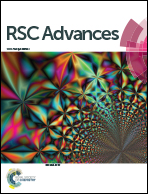Ag-modified AgI–TiO2 as an excellent and durable catalyst for catalytic oxidation of elemental mercury
Abstract
AgI–TiO2 was employed for the removal of elemental mercury (Hg0) from flue gas, and extra elemental silver (Ag) was introduced to enhance the catalytic activity and stability. AgI–TiO2 displayed an excellent effect on Hg0 catalytic oxidation, and the Hg0 oxidation efficiency was almost 100% with only 5 ppm HCl at 350 °C, which was better than that of KI–Ti. Adding Ag to AgI–TiO2 can notably prolong the period of high efficiency, and the Hg0 oxidation efficiency was still above 90% after 10 h with only 2% Ag added. Doping with silver could suppress the decomposition of AgI and the loss of iodine, which maintains the stability of the catalyst performance. In addition, HCl was readily adsorbed and activated by the silver. The iodine in Ag(2%)–AgI–Ti mainly acted as an accelerant for Hg0 oxidation by facilitating formation of the intermediate Hg–I*; then, chlorine can further convert the intermediate to HgCl2 as the final product. In addition, the thermogravimetric (TG) analysis proved that Ag(2%)–AgI–Ti showed a good stability at high temperature. Furthermore, the ion chromatogram tests also showed the chemical stability of AgI–Ti in the presence of Ag.


 Please wait while we load your content...
Please wait while we load your content...